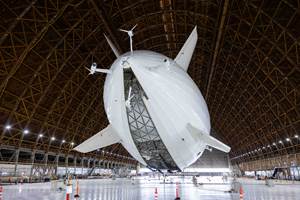Blue Origin to manufacture its orbital launch vehicle at Space Coast
Blue Origin’s American-made BE-4 engine – the power behind its orbital launch vehicle – will be acceptance tested at the facility.
Blue Origin, (Kent, WA, US) a privately-funded aerospace company owned by Amazon.com founder Jeff Bezos, selected Florida’s Space Coast as the site for the company’s next multi-million-dollar manufacturing and processing facility.
Blue Origin’s Orbital Launch Vehicle (OLV) will be designed, manufactured, launched and ultimately returned to Brevard County, FL. This marks the first time all aspects of commercial spacecraft development and launch will be completed within the Space Coast.
Blue Origin plans to create 330 jobs with an average wage of $89,000, and will make a significant capital investment of $205 million over five years through the selection of a site in Exploration Park, just south of Kennedy Space Center in Titusville, FL. The company is expected to break ground on the new processing facility in early 2016.
“This announcement is the result of a marriage of visions,” said Space Florida President and CEO Frank DiBello. "It is Florida’s vision to be the world’s greatest spaceport and Blue’s vision to push the boundaries of space travel. Nothing is more exciting than the arrival of an historic business venture that brings with it prosperity and the promise of exploring the stars.”
“One of the unique things about our Florida operations is that we aren’t just launching here, we’re building here,” Bezos said. “At Exploration Park, we’ll have a 21st century production facility where we’ll focus on manufacturing our reusable fleet of orbital launchers and readying them for flight again and again. Locating vehicle assembly near our launch site eases the challenge of processing and transporting really big rockets. We’ll be launching from here later this decade. You will hear us before you see us.”
Blue Origin’s American-made BE-4 engine – the power behind its orbital launch vehicle – will be acceptance tested at the facility. The BE-4 engine will also help make history as it powers the first flight of United Launch Alliance’s (ULA, Centennial, CO, US) Vulcan rocket.
Expanding production agreement
ULA and Blue Origin recently agreed to expand production capabilities for the American-made BE-4 engine for the Vulcan. The companies say that the BE-4 engine offers the fastest path to a domestic alternative to the Russian RD-180. Development is on schedule to achieve qualification for flight in 2017 to support the first Vulcan flight in 2019.
“This agreement gets us closer to having an affordable, domestic and innovative engine that will help the Vulcan rocket exceed the capability of the Atlas V on its first flight and open brand new opportunities for the nation’s use of space,” said Tory Bruno, president and chief executive officer of ULA. “This partnership enables each company to leverage its strengths, with ULA bringing production excellence and mission assurance, and Blue Origin bringing innovative engineering concepts and a commitment to lowering the cost of spaceflight.”
“The BE-4 engine test program is well underway with more than 60 staged-combustion tests already on the books,” Bezos said. “This new agreement is an important step toward building BE-4s at the production rate needed for the Vulcan launch vehicle.”
The Vulcan rocket brings together decades of experience on ULA’s reliable Atlas and Delta vehicles, combining the best features of each to produce an all-new, American-made rocket that will enable mission success from low Earth orbit all the way to Pluto.
The BE-4 is a liquid oxygen, liquefied natural gas (LNG) rocket engine that delivers 550,000-lbf of thrust at sea level. Two BE-4s would power each ULA Vulcan booster, providing 1,100,000-lbf thrust at liftoff. ULA is teaming in the development of the BE-4 to enable availability for national security, civil, human and commercial missions. Development of the BE-4 engine has been underway for more than three years and testing of the BE-4 components is ongoing at Blue Origin’s test facilities in West Texas.
Related Content
Next-generation airship design enabled by modern composites
LTA Research’s proof-of-concept Pathfinder 1 modernizes a fully rigid airship design with a largely carbon fiber composite frame. R&D has already begun on higher volume, more automated manufacturing for the future.
Read MoreThe potential for thermoplastic composite nacelles
Collins Aerospace draws on global team, decades of experience to demonstrate large, curved AFP and welded structures for the next generation of aircraft.
Read MorePEEK vs. PEKK vs. PAEK and continuous compression molding
Suppliers of thermoplastics and carbon fiber chime in regarding PEEK vs. PEKK, and now PAEK, as well as in-situ consolidation — the supply chain for thermoplastic tape composites continues to evolve.
Read MorePlant tour: Middle River Aerostructure Systems, Baltimore, Md., U.S.
The historic Martin Aircraft factory is advancing digitized automation for more sustainable production of composite aerostructures.
Read MoreRead Next
“Structured air” TPS safeguards composite structures
Powered by an 85% air/15% pure polyimide aerogel, Blueshift’s novel material system protects structures during transient thermal events from -200°C to beyond 2400°C for rockets, battery boxes and more.
Read MoreVIDEO: High-volume processing for fiberglass components
Cannon Ergos, a company specializing in high-ton presses and equipment for composites fabrication and plastics processing, displayed automotive and industrial components at CAMX 2024.
Read MoreAll-recycled, needle-punched nonwoven CFRP slashes carbon footprint of Formula 2 seat
Dallara and Tenowo collaborate to produce a race-ready Formula 2 seat using recycled carbon fiber, reducing CO2 emissions by 97.5% compared to virgin materials.
Read More


























